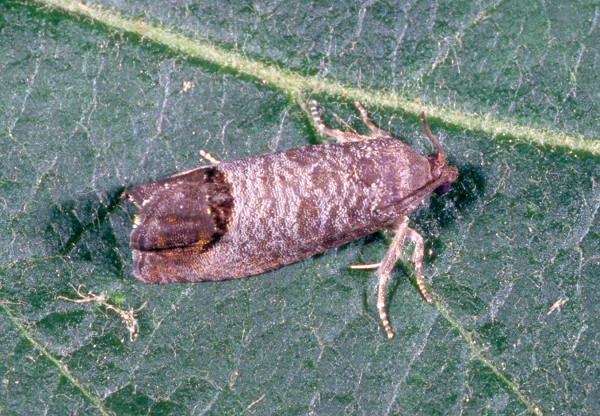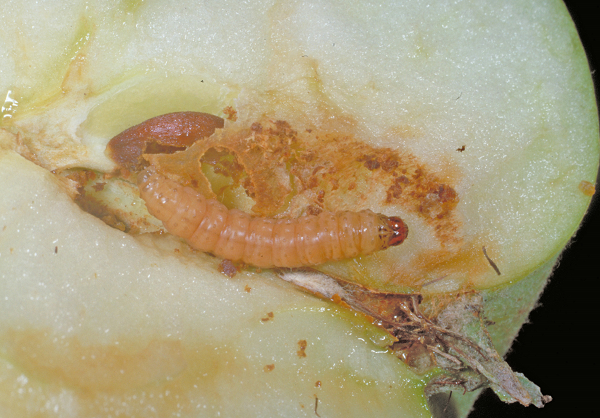Codling Moth
ENTFACT-203: Codling Moth | Download PDF
by Ric Bessin, Extension Specialist
University of Kentucky College of Agriculture
The codling moth larva is one of the very destructive pests introduced from Europe by settlers. This is the ‘worm in the apple.’ While it can attack various fruits, it primarily damages apples. This is a key pest of apples that requires management in every orchard in Kentucky.
Identification and Biology
Female moths lay individual scale‑like eggs on developing fruit or adjacent leaves or stems at night. Upon hatching the larva enters into the calyx end or side of the fruit then tunnel to the center where they feed and develop. Brown frass is often noticed near the calyx end of the developing fruit. The larva is pinkish to white in color with a brown head and can reach 3/4 inch. Larval development is completed in 3 to 5 weeks. Larvae exit the fruit to pupate in a thick silken cocoon on the bark or other protected areas. The fully developed larva is the overwintering stage. Pupation occurs in spring beginning about the same time as bloom with adults emerging in late April or early May. In Kentucky, there are three generations each year. The adult is about 3/8 inch, gray, with distinctive bronze areas on the bottom 1/3 of the wing.

Figure 1. Adult codling moth showing characteristic coloration of tip of wings.
Control of codling moth in commercial orchards relies on three tools: regular scouting of the trees and fruit, pheromone trapping, and the use of weather monitoring and degree day models. Orchards should be scouted twice a week early in the season and on a weekly basis for insects and mites during mid‑season. Closer to harvest scouting visits may be stretched to two weeks apart.
Pheromone Trapping
Pheromone trapping uses chemical lures to attract male moths. These chemical lures are synthetic copies of the chemicals female moths use to attract males for mating. A trap consists of plastic top and bottom held together by a wire hanger with the lure placed inside. The inner surface of the bottom is coated with a sticky material to hold the insects once they land in the trap. Traps are hung in the southeast quadrant of the tree at eye level, usually one for each ten acres of trees (minimum of two traps per orchard) in commercial orchards.

Figure 2. Codling moth larva feeding in the apple core.
Homeowners can use pheromone traps to time insecticide sprays by identifying when peak flight periods are occurring. See the section on degree days to time applications following peak flights. Some homeowners have attempted to "trap out" all the male moths. This involves using enough pheromone traps such that all of the male moths are captured before the female moths mate. Female moths are then able to lay only unfertilized eggs that will not develop. Typically, 2 to 4 traps per tree are required for this to be successful. This is less effective if there are additional sources of mated females, such as other trees in the neighborhood or wild hosts. Pheromone traps should be put out at the pink stage of bud development. Every month, pheromone lures need to be replaced. Codling moths can be distinguished from other insects in the traps by their bronze wing tips. Pheromone trap suppliers can be found by searching the internet.
Degree Day Accumulation
Initial trap catches for adult moth in the early spring are termed biofixes. This information will be used to predict when egg hatch will occur and synchronize insecticide sprays. The biofix for the codling moth is the starting date of the first sustained flight of male moths captured in pheromone traps. Generally, this is when the fifth moth has been captured in the trap. A few moths often emerge very early in the spring ahead of the rest. Using the fifth moth as the biofix better represents when the majority of the codling moths begin to emerge. This usually occurs just after petal fall. Codling moth traps need to be examined daily in order to know exactly when the biofix occurs. After the biofix has occurred, degree days are calculated on a daily basis and a running total is kept (see "Predicting Insect Development Using Degree Days" in ENTFACT 201). The codling moth has a 50°F threshold temperature. The UK Ag Weather Center has a codling moth degree day model that provides these values based on the temperatures in your county, users just need to enter the date of biofix.
Throughout the growing season in commercial IPM orchards, pheromone trap catches that exceed an average of five moths per trap per week can tripper an insecticide application. Growers need to estimate the residual activity of previous insecticide sprays (generally 10 to 14 days of activity after each application) relative to the anticipated egg hatch predicted by the degree day accumulation to determine the need for additional sprays.

Trunk Banding
Another tactic that can be used by home owners is the use of cardboard bands placed around the trunk of the trees to serve as pupation sites for the wandering larvae. A four to six inch band encircling the trunk or scaffold limbs will attract the larvae. Bands should be in place before larvae begin to leave the apples in search of pupation sites and removed and destroyed before moth emergence begins. Bands should be placed on trees in August to capture overwintering pupae and removed and destroyed in December. Bands can also be used in the summer to capture pupae from the summer generations, but timing is more difficult.
Sanitation
Home owners should also pick up and destroy fallen fruit. Often fruit that drop prematurely are infested with either codling moth or plum curculio larvae. For more information on reduced insecticide apple management, see ENTFACT‑201, Apple Insect Control with Reduced Insecticide Usage.
Pesticide Resistance
Codling moth resistance to some of the older insecticides that had been used for control. Fortunately, there are new labeled insecticide alternatives for codling moth control on apples with different modes of action. Growers should not rely on a single insecticide mode of action throughout the year to control codling moth. I recommend switching to a different mode of action with each new generation during the year.
Mating Disruption
Mating disruption relies on confusion to prevent codling moths from mating. Male codling moths locate female moths at night by following the sex attractant released into the air by the females. Mating disruption uses commercial dispensers of synthetic sex attractant to prevent male moths from locating females. Unfertilized moths are not able to lay viable eggs. Unlike other methods, codling moths are not killed with this technique. This technique is most successful in blocks of at least 5 acres and where initial populations of codling moth are low. Keep in mind that mating disruption for codling moth will not control other insects that are normally controlled with cover sprays (plum curculio or Oriental fruit moth for example).
Revised: 2/10
CAUTION! Pesticide recommendations in this publication are registered for use in Kentucky, USA ONLY! The use of some products may not be legal in your state or country. Please check with your local county agent or regulatory official before using any pesticide mentioned in this publication.
Of course, ALWAYS READ AND FOLLOW LABEL DIRECTIONS FOR SAFE USE OF ANY PESTICIDE!
Photos courtesy Ric Bessin, University of Kentucky Entomology
